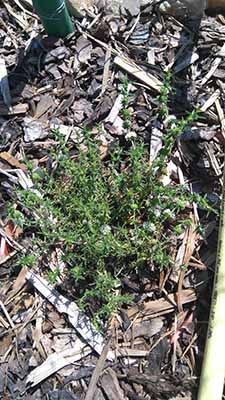Mentha cervina L. (Lamiaceae)






| ENG | Hart's pennyroyal |
| SK | |
| CZ | Máta parožnatá |
| PL | |
| HU |
Using
In Mediterranean the species is often harvested and marketed on a local scale for medicinal use. The leaves have a strong spearmint fragrance and can be used to make herbal tea. In Portugal Mentha cervina is traditionally used in folk medicine, to cure different gastric disorders and inflammations of the respiratory tract.
Hart's pennyroyal contains essential oils 2.4-4% (pulegone, isomenthone, piperitenone), flavonoids.
| I. | II. | III. | IV. | V. | VI. | VII. | VIII. | IX. | X. | XI. | XII. | |||||||||||||
| Sowing | ||||||||||||||||||||||||
| Planting | ||||||||||||||||||||||||
| Propagation/ Vegetative | ||||||||||||||||||||||||
| Harvest | ||||||||||||||||||||||||
Botanical description and occurrence:
Is a prostrate plant, growing up to 30 cm tall. Habit is upright when flowering. Hart's pennyroyal is native in the western Mediterranean from France south to the Azores and Algeria. It is very closely related to the "real" pennyroyal (Mentha pulegium) it has very fragrant leaves which are narrow lanceolate, greyish-green. Upright stems hold inflorescence with small flowers in dense verticillasters.
It can be found in wetlands and temporarily flooded habitats (pools, rivers, meadows). Normally overwintering under water in its native habitat, spring growth erect with stems in aerenchym.
Mentha cervina is a perennial species (hemicryptophyte) that blooms in summer (VII-VIII), rose-coloured flowers, variety ´Alba´ has white-coloured flowers. The flowers are hermaphrodite (have both male and female organs) and are pollinated by insects. It is noted for attracting wildlife. Mentha cervina is a heliophilous species, sensitive to the shade and to the modification of water regimes.
In France, the species is protected at national and regional level (Provence-Alpes-Côte-d'Azur) and is found in the Natural Reserve of Roque-Haute. It is classed as Vulnerable in the Red Data Book.
Mentha cervina is propagated mainly vegetatively from cuttings or generative.
Why to have the plant in your garden:
Mentha cervina ´Alba´ is an ornamental plants with white flowers.
Mentha cervina essential oils with low content of pulegone, may be an alternative as antifungal agents in dermatophytosis. Leaves can be harvested at any time. They are best used fresh and have a short storage life.
Text:
Dr. Jarmila Neugebauerová, Mendel University in Brno, Czech Republic
Photo:
Dr. Jarmila Neugebauerová, Mendel University in Brno, Czech Republic, Dr. Dr. Jan Mezey, SUA, Nitra, Slovak Republic

